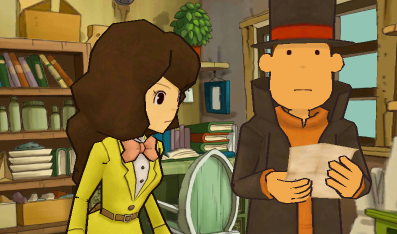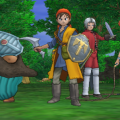Professor Layton and the Miracle Mask is the fifth game in the Professor Layton series, and the second game of the second trilogy. Up to here, the games have been very much cast in the same mold; what else could Layton offer other than more of the same? Quite a bit, in fact: this is the first game for the 3DS, and the game attempts to shake things up at several spots, which is more than welcome. The second trilogy is a prequel to the first one, with the previous episode seeing Layton meet Luke for the first time and them investigating with Layton’s assistant, Emily; the timeline then continues with Professor Layton and the Eternal Diva, a feature-length anime centering on an opera singer and the fabled lost kingdom of Ambrosia. The Miracle Mask is set after this movie, although you do not need to have seen it to enjoy the game, as there are just a couple of references closer to the end.
This fifth opus uses the new platform to great effect, with a new presentation that blows new life into the series. It takes full advantage of the extra processing power and the top screen’s 3D capabilities to make the characters come alive; most of the game now happens on the top screen, and Layton and all the other characters are no longer 2D sprites, but cel-shaded animated 3D models. This is at first jarring: the characters sometimes seem to be mounted on springs, and Layton’s eyes do not translate well to a more realistic style; but you do get used to it, and the animations during the dialogues do make the game very lively. The backgrounds are still two-dimensional, but have several layers of 3D depth to enhance the presentation; the effect with the 3DS’ 3D turned on is not unlike a puppet theatre, which is fitting for Layton’s atmosphere.
However, this use of the top/3D screen is unconventional for a Layton game, and means the interface needs to change a bit. Since the player cannot touch the scene with the stylus, there is now a magnifying glass cursor on the top screen that is moved by sliding the stylus on the bottom screen. This changes the controls quite a bit: the areas that can be interacted with are highlighted in orange upon hovering, which some reviewers dislike, as it reveals the hint coins’ hiding places (although they really have never been very well hidden in the previous episodes either). The interface during the puzzles is a bit more awkward: the text now appears on the bottom screen, on top of the input area, in order for the top screen to display something in 3D – which means you sometimes (for logic puzzles, for instance), have to switch between showing and hiding the text several times during a puzzle. This is all done in the name of showing more 3D effects, which are almost all very well done (apart from the occasional ghosting effect), but this does change habits and requires a bit of adaptation.
The Miracle Mask‘s story is set in Monte d’Or, a bustling desert town full of tourists and casinos, and heavily features characters from Layton’s past; in fact, the game jumps back and forth between the Monte d’Or setting and Layton’s teenage years, and a traumatic situation that drove the characters apart. The main characters each have a strong voice, although Emily feels even more underutilized than in the previous game, which is a shame for such a major character and one of the only women in the Layton series. Unlike the previous game she basically doesn’t spring into action, her role is ill-defined, she is a blank slate of a character, and what is supposed to be good-natured ribbing with Luke sometimes feel like, well, a grown woman picking on a kid, which doesn’t do much to make her sympathetic; at this point it feels like Level-5 does not quite know what to do with her. Although the story is, again, a bit too convoluted for its own good towards the end, it mostly makes sense, and its treatment of the emotional situations shows quite a bit more subtlety and sensitivity that previous episodes. Once again, the puzzles are rarely integrated in the narrative, with numerous flimsy excuses to be found. Also notable is the fact that the game attempts to shake things up and introduce new mechanics in two occasions: a chase scene in full 3D near the beginning, as well as a lengthy “puzzley dungeon crawler” sequence. Although the core gameplay is the same, with once again point-and-click and over 150 puzzles to solve, the fact that Level-5 sought to push beyond this and innovate is very interesting and shows they cared about making sure players don’t get tired of the series.
The dungeon crawler sequence, however, lasts over two hours, and comes at around the 12th hour of gameplay. This is the main issue with”Miracle Mask: it is just too long. Previous Layton episodes were about 12 hours long; but this is a 16-18 hours long game, and not all of these hours are interesting – far from it. The first chapter of the game is about 3 hours long, and only contains 12 puzzles; the rest is spent talking and going to various places in the city. The game’s pace doesn’t really pick up until the fifth hour, and even then, it is far from frenetic. Things get worse around the 10th hour, with sidequests and characters openly making you waste your time; by the time you reach the dungeon crawling section, it is understandable if you don’t feel motivated to painstakingly learn new gameplay rules, and you might ask yourself whether this section is more padding. Although it is a fun setting, there are close to 20 puzzles in that section that follow the same pattern, and the writing is repetitive, and actually misses occasions to deepen Layton’s character. The final act is set once again in a giant tower, and is several hours long with relatively few cutscenes. Overall, the game has pacing issues, and some of the content could have been left on the cutting room floor; this might be a symptom of the game trying to do too much, i.e. new mechanics, following two narrative threads, and more puzzles than ever.
Puzzle-wise, this entry has a few tricks up its sleeve; apart from the aforementioned interface changes, some of the puzzles get a very neat 3D presentation, and some even use the 3DS’s embedded gyrometer. But the difficulty seems to be dialed down even further, with very few headscratchers even in the endgame; and none of the mechanics are particularly inventive, unlike previous episodes, which always had a few with great framing/mechanics. The number of picarats is even less of a reliable indicator, as basically all the puzzles are between 30 and 40 picarats, even if their difficulty varies more than that (but mostly on the easier side). The previous episode introduced special puzzles, whose resolution was compulsory to move the story forward; these are still there, and mostly re-centered on following Layton’s deductions, which is a good although still underutilized idea. Finally, there are still three minigames: one with a robot (very similar to #2’s hamster or #3’s car), one with a rabbit (a bit tricky and finnicky), and one with a shop (which is just excellent, both in terms of framing and of progressive, meaty difficulty curve).
Finally, we can briefly touch on the artistic direction of the game. The new, 3D characters are a pretty cohesive bunch, contrasted to some of the previous episodes; their animations are well done, apart from some wobbly movements, but the way they emote along a line is most often very appropriate. Although Chelmey and Barton are nowhere to be seen, Inspector Grosky is back, and although one-dimensional, is a comedic highlight, with a very well-done model and his own special effect. Sound-wise, quite a few lines are dubbed, and the acting is mostly good; the sound effects are still sparkling and light. However, the soundtrack is a little bit of a disappointment, especially compared to the previous episode; in particular, the main theme is rather grating, and you’ll likely hear its first few seconds hundreds of times. (It is hard to not speculate why this soundtrack is the only one that did not get a separate release.)
In the end, this fifth episode’s changes are a net positive, as it manages to keep the basics of the series while reinventing its presentation and interface in a way that utilizes the 3DS’s capabilities to make the game even more charming. The new experiments with mechanics are a welcome addition, and the story is a notch above previous episodes’; however, it can feel like a slog, as the game probably did not need to be that long, which is probably the biggest criticism that can be levelled at the game. Still, the quality of this fifth episode means that Level-5 is still taking care of the franchise, and extending its shelf life for more episodes.


